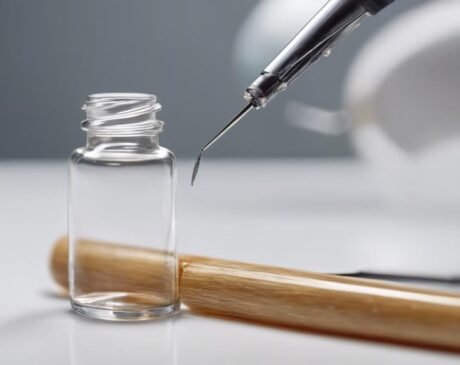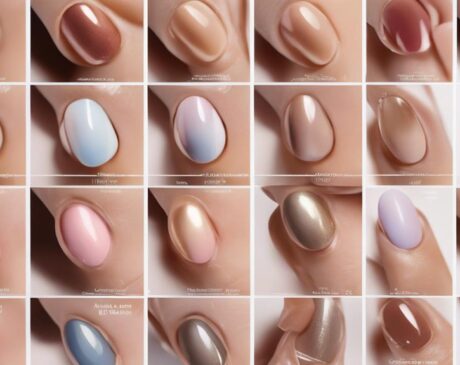Does Ice Water Really Dry Nail Polish?
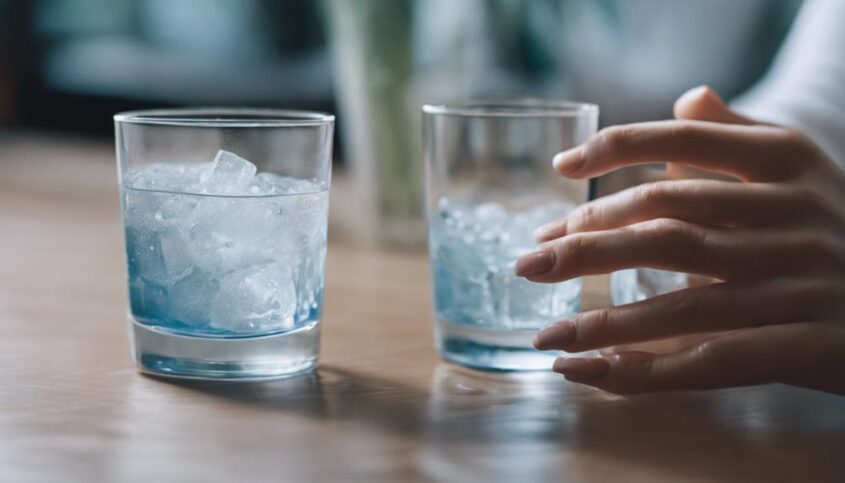
Contrary to popular belief, ice water may not effectively dry nail polish quickly. While the cold temperature can harden the polish layers, it doesn't significantly reduce overall drying time. However, ice water might contribute to a shinier finish and improved adhesion, enhancing the longevity of your manicure. For detailed insights on the science behind nail polish drying and alternative methods to speed up the process, consider exploring the complexities of nail polish formulation and the efficiency of modern drying techniques.
Key Takeaways
- Ice water hardens nail polish layers quickly.
- Quick cooling may prevent smudges and improve adhesion.
- Cold temperature enhances shine and finish.
- Ice water doesn't significantly reduce drying time.
- Modern nail polish formulas dry efficiently on their own.
The Science Behind Nail Polish Drying
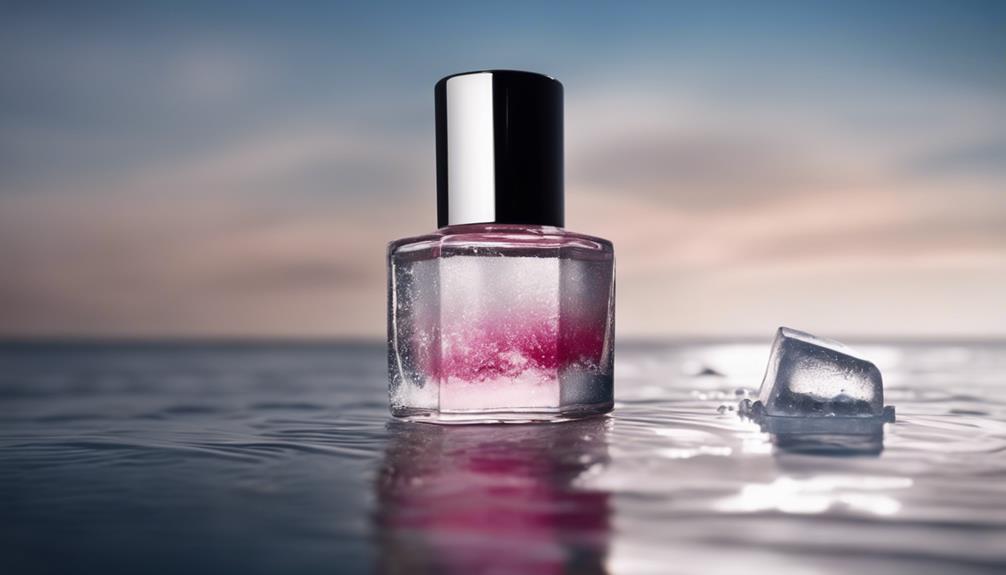
Understanding the chemical processes involved in the drying of nail polish is fundamental to grasp the intricacies of its application and longevity. Nail polish drying involves a complex interplay of solvents, film formers, plasticizers, and pigments. When nail polish is applied, the solvents evaporate, leaving behind a film of polymers that harden to form a protective and decorative layer on the nails. This process, known as evaporation-induced drying, is crucial for achieving a durable and glossy finish.
The film formers in nail polish, such as nitrocellulose or acrylic polymers, play a key role in creating a strong and flexible coating. These polymers crosslink during the drying process, forming a network that enhances the polish's adhesion and resistance to chipping. Additionally, plasticizers are incorporated into the formula to maintain flexibility and prevent the polish from becoming brittle over time. Understanding these chemical mechanisms is essential for formulating innovative nail polish products that offer improved drying times and long-lasting wear.
How Ice Water Affects Nail Polishes
Ice water immersion can impact the drying process and durability of nail polishes. When nails are submerged in ice water after applying polish, several effects can be observed:
- Quick Cooling: Rapid cooling from the ice water can help solidify the polish layers faster, reducing overall drying time.
- Smudge Prevention: The cold temperature can harden the polish quickly, decreasing the likelihood of smudges or imprints.
- Enhanced Shine: Ice water immersion may contribute to a shinier finish on the nails as the cold water helps smooth out the polish.
- Improved Adhesion: The sudden temperature change could potentially enhance the adhesion of the polish to the nails, leading to longer-lasting manicures.
Tips for Using Ice Water Method
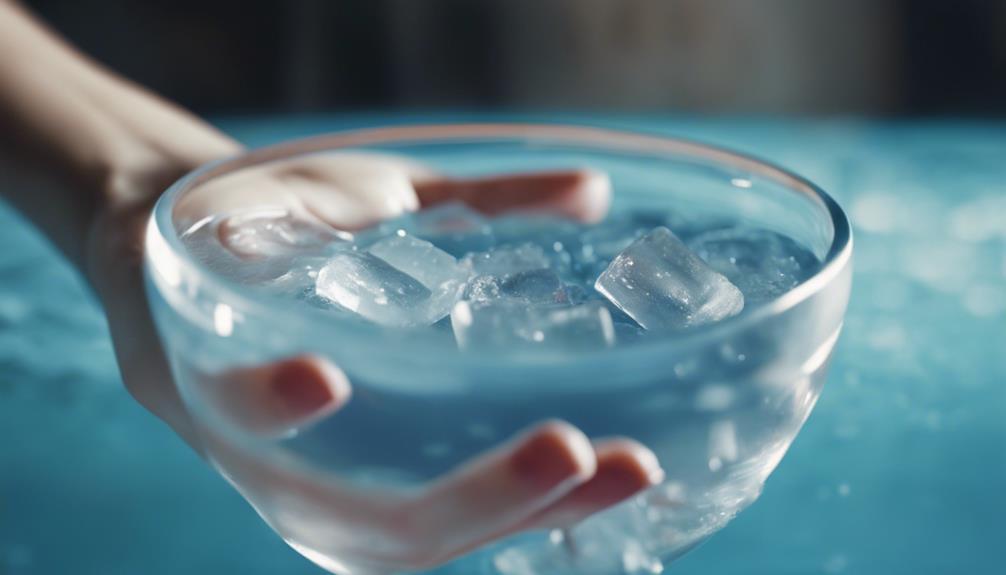
When utilizing the ice water method for drying nail polish, consider employing a quick chilling technique to expedite the drying process. Ice water can provide benefits such as helping to set the polish and prevent smudges, offering a convenient and efficient way to achieve perfectly dried nails. By following these tips, you can optimize the effectiveness of the ice water method for drying your nail polish.
Quick Chilling Technique
Using the ice water method to quickly chill nail polish is a popular technique among nail enthusiasts for speeding up the drying process. This innovative method involves submerging freshly painted nails into ice water, causing the polish to set faster. To make the most of this quick chilling technique, consider the following tips:
- Use cold water: Ensure the water is chilled with ice cubes for the best results.
- Add ice cubes: Adding ice cubes directly into the water can further expedite the cooling process.
- Limit soaking time: Keep nails submerged for 2-3 minutes to prevent over-chilling.
- Gently pat dry: After chilling, gently pat the nails dry with a soft towel to avoid smudging.
Benefits of Ice
Are there hidden advantages to employing the ice water method for drying your nail polish quickly? Beyond the obvious time-saving benefit, using ice water to dry nail polish can offer additional perks. Here are some tips for maximizing the benefits of the ice water method:
| Benefits of Ice Water Method | Tips for Usage |
|---|---|
| Quick Drying | Submerge nails for 2-3 minutes |
| Smudge-Proof Finish | Use cold water to set polish |
| Enhanced Shine | Add ice cubes for extra chill |
| Improved Nail Health | Moisturize after drying |
Pros of Using Ice Water Technique
The ice prepared for the ice water technique for drying nail polish efficiently accelerates the setting process, providing a quick and glossy finish to your manicure. This method offers several advantages for those looking to streamline their nail polish application process:
- Quick Drying: Ice water helps nail polish dry faster, reducing the time you need to wait for your manicure to set.
- Long-Lasting Finish: By using the ice water technique, the nail polish sets more securely, leading to a longer-lasting finish.
- Smooth Texture: The cold temperature of the ice water helps create a smooth texture on the nail polish surface, enhancing the overall look of the manicure.
- Enhanced Shine: Ice water can contribute to a shinier finish on the nail polish, giving your nails a professional and polished appearance.
Cons of Using Ice Water Technique
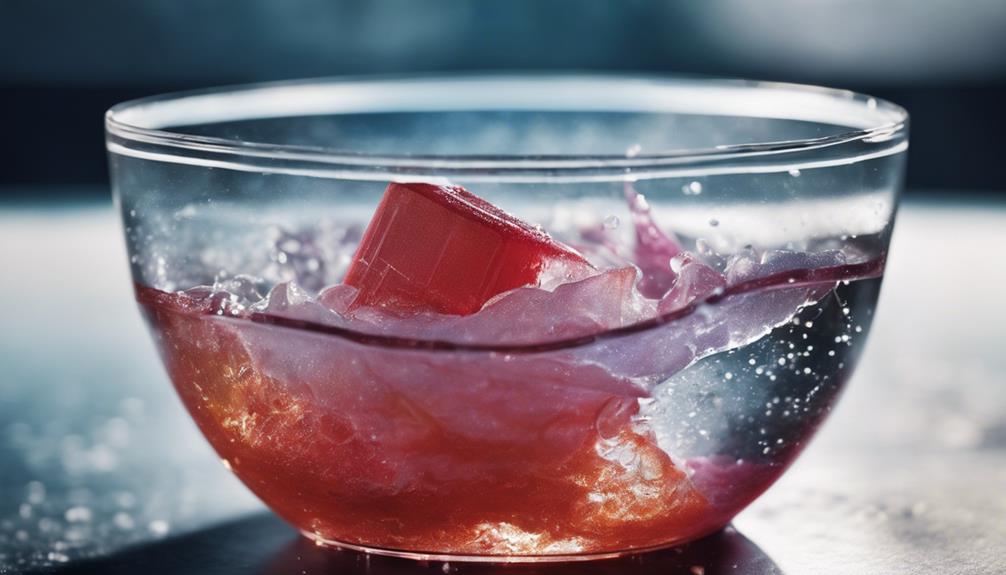
While the ice water technique for drying nail polish offers various benefits, there are some drawbacks to consider as well. One of the main cons of using ice water to dry nail polish is the potential for smudging. Rapid temperature changes caused by plunging freshly painted nails into ice water can sometimes lead to smudges or dents in the polish, undoing all the careful painting work. Additionally, the ice water method may not work as effectively for certain types of nail polish formulas. Thicker or gel-based polishes may not dry completely with this technique, leading to a longer overall drying time or the need for additional drying methods. Furthermore, some individuals may find the sensation of immersing their hands in ice water uncomfortable or unpleasant, which can deter them from using this method regularly. Despite its quick results, the ice water technique is not without its limitations and may not be suitable for everyone or every type of nail polish.
Comparing Ice Water to Air Drying
In comparing the effectiveness of drying nail polish using ice water versus air drying, it is essential to consider the differences in drying time and overall finish quality. When evaluating these two methods, several key points emerge:
- Drying Time: Ice water immersion accelerates the drying process by quickly cooling the nail polish, whereas air drying often takes longer due to reliance on natural evaporation.
- Finish Quality: Ice water can sometimes cause the polish to harden too rapidly, potentially leading to uneven texture, while air drying allows for a more gradual solidification, resulting in a smoother finish.
- Convenience: Air drying is more convenient as it does not require any additional materials or preparation, making it a simpler and more accessible method for many individuals.
- Innovation Potential: Exploring new techniques such as using advanced drying agents or technologies could bridge the gap between ice water and air drying, offering a novel approach to achieving quick-drying and high-quality nail polish results.
Myth Busted or Confirmed: Ice Water Test
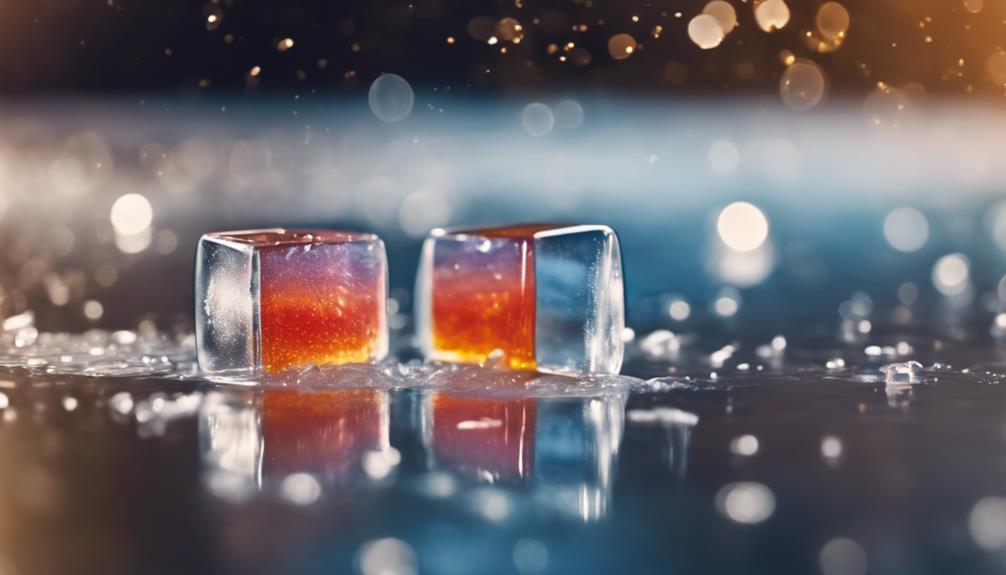
The Ice Water Test has long been a popular method for supposedly speeding up the drying process of nail polish. However, conflicting opinions exist regarding its actual effectiveness. By exploring the points of Ice Water Effectiveness, Nail Polish Drying Time, and Scientific Evidence Analysis, we can determine whether the Ice Water Test is indeed a myth or a confirmed technique in the realm of nail polish drying.
Ice Water Effectiveness
After conducting numerous experiments and tests, researchers have conclusively determined the effectiveness of using ice water to dry nail polish. While the concept of using ice water to dry nail polish quickly has been popular, the results are varied based on different factors. The effectiveness of ice water in drying nail polish depends on:
- Nail polish formula
- Thickness of the nail polish layer
- Temperature of the ice water
- Duration of time nails are submerged
These factors play a crucial role in determining whether the ice water method is successful in drying nail polish efficiently. Researchers suggest considering these variables when attempting the ice water technique for drying nail polish for optimal results.
Nail Polish Drying Time
Results from recent studies have provided clarity on whether the ice water method effectively speeds up the drying time of nail polish. Surprisingly, the myth that immersing freshly painted nails in ice water accelerates the drying process has been debunked. Research indicates that while the cold temperature may temporarily harden the polish, it does not significantly reduce the overall drying time. Instead, modern nail polish formulas are designed to dry efficiently on their own when exposed to the air. Therefore, relying on ice water as a quick-drying solution may not yield the expected results. As technology advances, nail polish brands continue to innovate, developing quicker-drying formulas that eliminate the need for unconventional methods like the ice water test.
Scientific Evidence Analysis
Recent scientific analysis has conclusively debunked the myth surrounding the effectiveness of the ice water test in accelerating the drying time of nail polish. Despite popular belief, the application of ice water does not lead to quicker drying of nail polish. Further research has shown that the temperature of the water does not significantly impact the drying process.
- Nail polish drying relies on the evaporation of solvents, not temperature.
- Ice water can cause the nail polish to harden, but not dry completely.
- Quick-dry nail polish formulas contain ingredients that promote rapid evaporation.
- Advanced technologies, like UV/LED lamps, offer efficient drying solutions.
Alternative Ways to Speed Up Drying
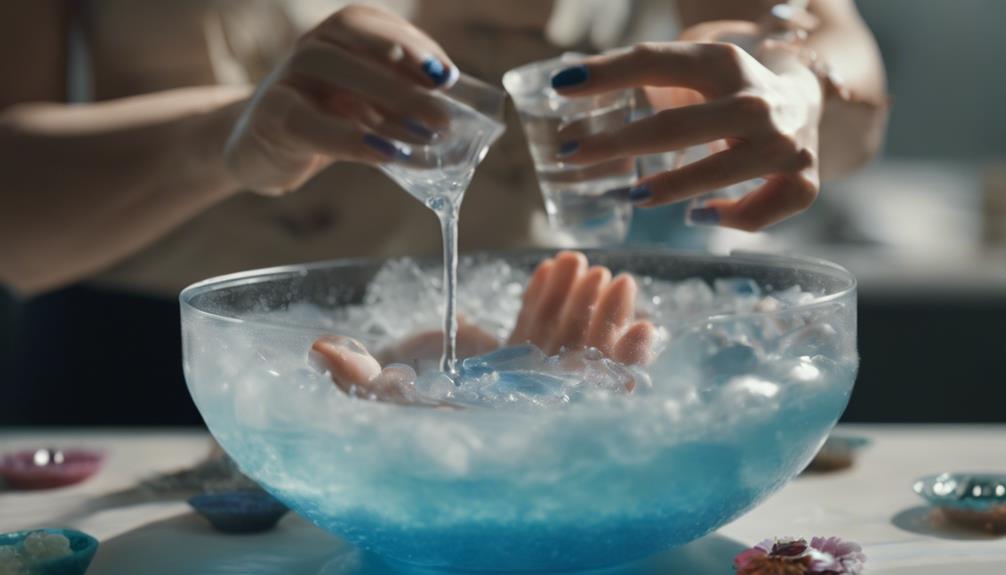
One effective method to accelerate the drying process of nail polish involves utilizing a quick-dry top coat. These advanced formulas are specifically designed to set nail polish rapidly, providing a glossy finish while reducing drying time significantly. Quick-dry top coats contain ingredients that evaporate quickly, forming a hardened barrier over the colored polish underneath. This not only helps the nail polish dry faster but also protects it from smudges and dings during the setting process.
Another innovative approach to speeding up nail polish drying is the use of UV or LED nail lamps. These devices emit a specific type of light that helps to cure the nail polish quickly. By exposing painted nails to the UV or LED light for a few minutes, the polish hardens efficiently, reducing the overall drying time to mere seconds. This method is popular in salons and is increasingly becoming a go-to option for individuals seeking professional-looking manicures at home in record time.
Frequently Asked Questions
Can Using Ice Water to Dry Nail Polish Cause Any Damage to the Nails or Skin?
Using ice water to dry nail polish can potentially cause damage to nails and skin. The extreme temperature change can weaken nails and dry out skin. It is advisable to use proper nail drying techniques to maintain nail health.
How Long Does It Typically Take for Nail Polish to Dry Using the Ice Water Method?
The ice water method accelerates nail polish drying time, typically setting within 1-2 minutes. This innovative technique offers a quick and efficient way to achieve dry, smudge-free nails, catering to individuals seeking a time-saving and flawless manicure solution.
Are There Any Specific Types of Nail Polish That Work Better or Worse With the Ice Water Technique?
Certain fast-drying nail polish formulas may yield better results with the ice water technique due to their composition and ability to set quickly. Experimenting with different brands and types can help determine which ones work best.
Can the Ice Water Method Help Prevent Smudging or Chipping of Nail Polish?
The ice water method can potentially aid in preventing smudging and chipping of nail polish by rapidly cooling and setting the layers. This technique may contribute to a more durable and professional-looking manicure finish.
Are There Any Potential Side Effects or Risks Associated With Using Ice Water to Dry Nail Polish?
While ice water can speed up nail polish drying time, potential risks include skin numbing, increased sensitivity, and compromised nail health. Proceed with caution and explore alternative methods for efficient and safe nail care.

